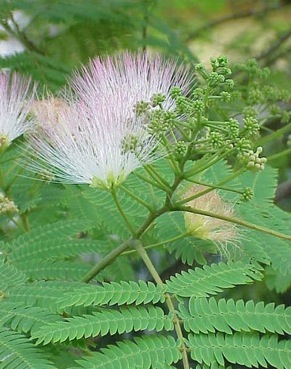Albizia julibrissin: Tripinnated Lunch
I was drinking “Mimosas” — orange juice and champagne — about 20 years before I discovered the Mimosa tree was edible. That makes some sense when you realize the tree and the drink have nothing in common except the name (so called because the drink was as smooth as the Mimosa blossom.)
Some sites on the Internet say the first tree came the United States in the early 1900s in California. This is doubtful. William Bartram, a botanist who explored Florida and followed a trail not one mile from here, wrote a letter to Thomas Jefferson in which he mentions the “mimosa.” He said they were introduced into North Carolina in the late 1700s by none the less than Andre Michaux, the original grand old man of botany in the New World. Gopher Apples are named after him, Licania Michauxii. The next question would be where did Michaux get them? The answer is Europe.
Botanically this Mimosa is Albizia julibrissin (al-BIZ-zee-uh jew-lih-BRISS-in) It was named after the Italian nobleman Filippo del Albizzi, who introduced the tree to Europe in the mid 1700’s. Julibrissin is a corruption of the Persian phrase “Gul-i Abrisham” which means ‘flower of silk.’ Where did Albizzi get it? The tree is native to southern and eastern Asia, from Iran east to China and Korea, perhaps even Japan where I saw it many a life time ago when I was in my early 20’s.
My particular tree was a seeding runt along a path I frequented. The long pod, horizontal seeds, and tripinnate leaf helped with the identification. It is not a large tree but in 200 years it has managed to spread up to southern New England, down to Florida, west through the Old South, across Texas, and up the west coast of the United States.
Usually very picturesque, it has graceful, lacy leaves and delicate, pink pompom-like flowers. Those are followed by a flat paper brown seed pods with the seeds perpendicular to the sides of the pod. They are not edible.* It’s young leaves, however, are edible cooked. The Mimosa (Silk Tree) also has numerous herbal and medical applications.
(*I have received one email from a fellow who says his grandmother used to serve him seeds in a tortilla, a practice I have not been able to confirm.)
Green Deane’s “Itemized” Plant Profile
IDENTIFICATION: A small deciduous tree growing to 40 feet, broad crown, level or arching branches. Bark is dark green/gray striped vertically as it ages. Leaves tripinnate, flowers densely throughout summer, no petals, a cluster of stamens, white, pink with a white base, looking like silky threads.
TIME OF YEAR: All times of year. Young leaves as long as it is producing them.
ENVIRONMENT: Prefers dry, waste areas, or up hill banks from roads, railroads and right of ways.
METHOD OF PREPARATION: Boiled young leaves. The blossoms are edible like a vegetable or crystallized. The seeds are NOT edible as far as I know.
HERB BLURB:
School of Pharmaceutical Sciences, Peking University Health Science Center, Beijing 100083, People’s Republic of China. Department of Natural Products Chemistry, Shenyang Pharmaceutical University, Shenyang 110016, People’s Republic of China. Accepted 2 February 2006.
Three new triterpenoid saponins, julibroside J29 (1), julibroside J30 (2), and julibroside J31 (3), were isolated from the stem bark of Albizia julibrissin Durazz. (Leguminosae) by using chromatographic method. Their structures were established by spectroscopic methods. Compounds 1, 2, and 3 displayed significant anti-tumor activities in vitro against PC-3M-1E8, HeLa, and MDA-MB-435 cancer cell lines at 10 ?M assayed by SRB and MTT methods.


